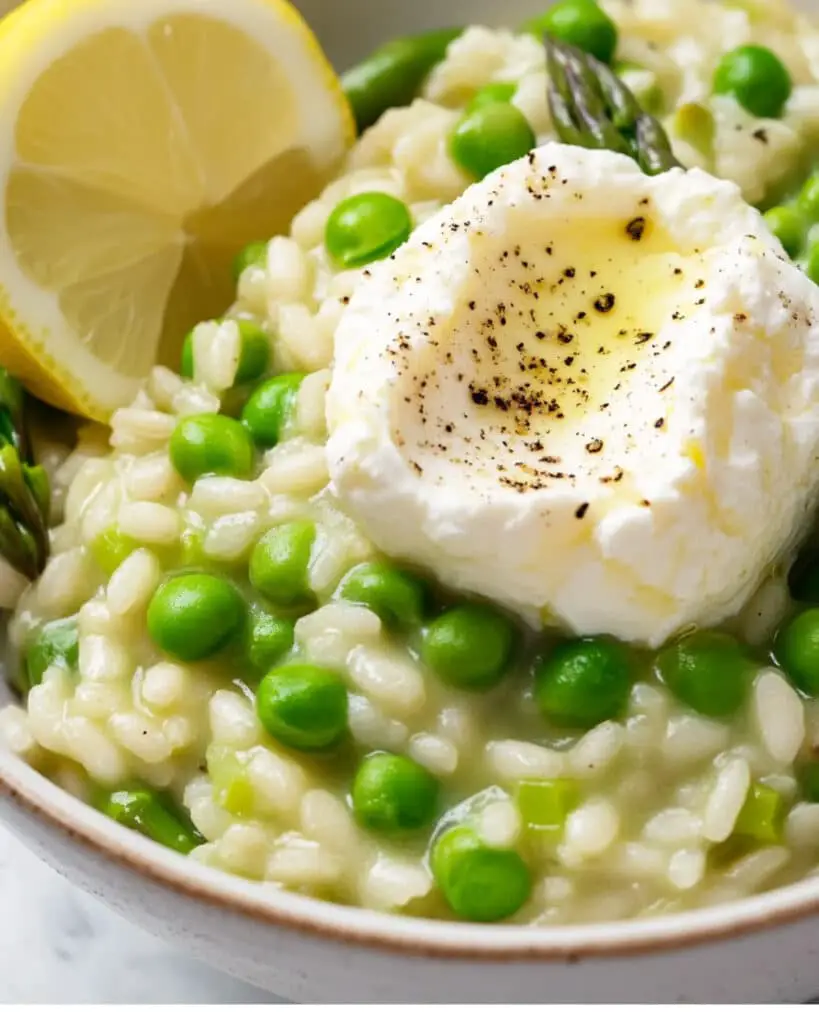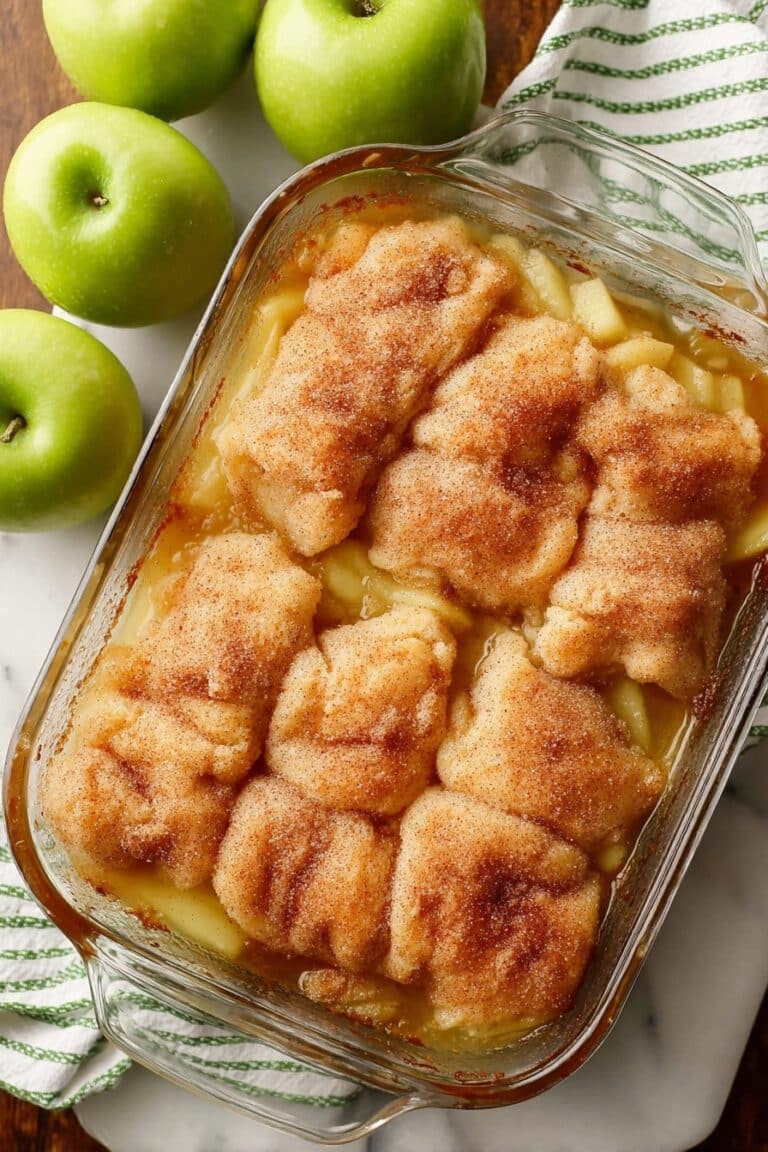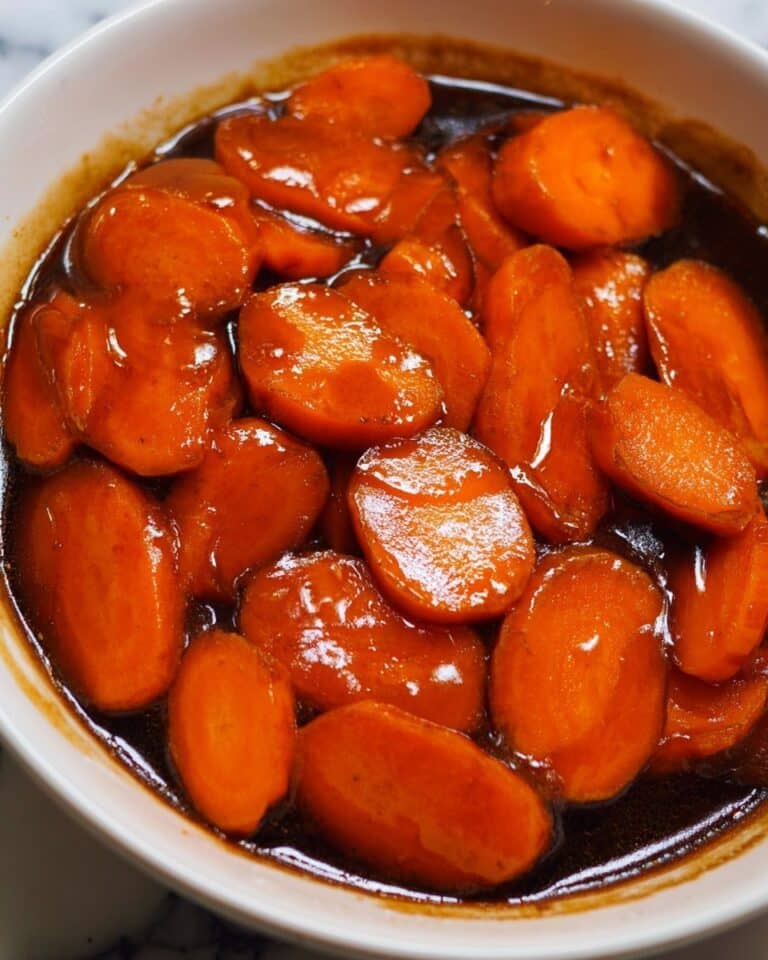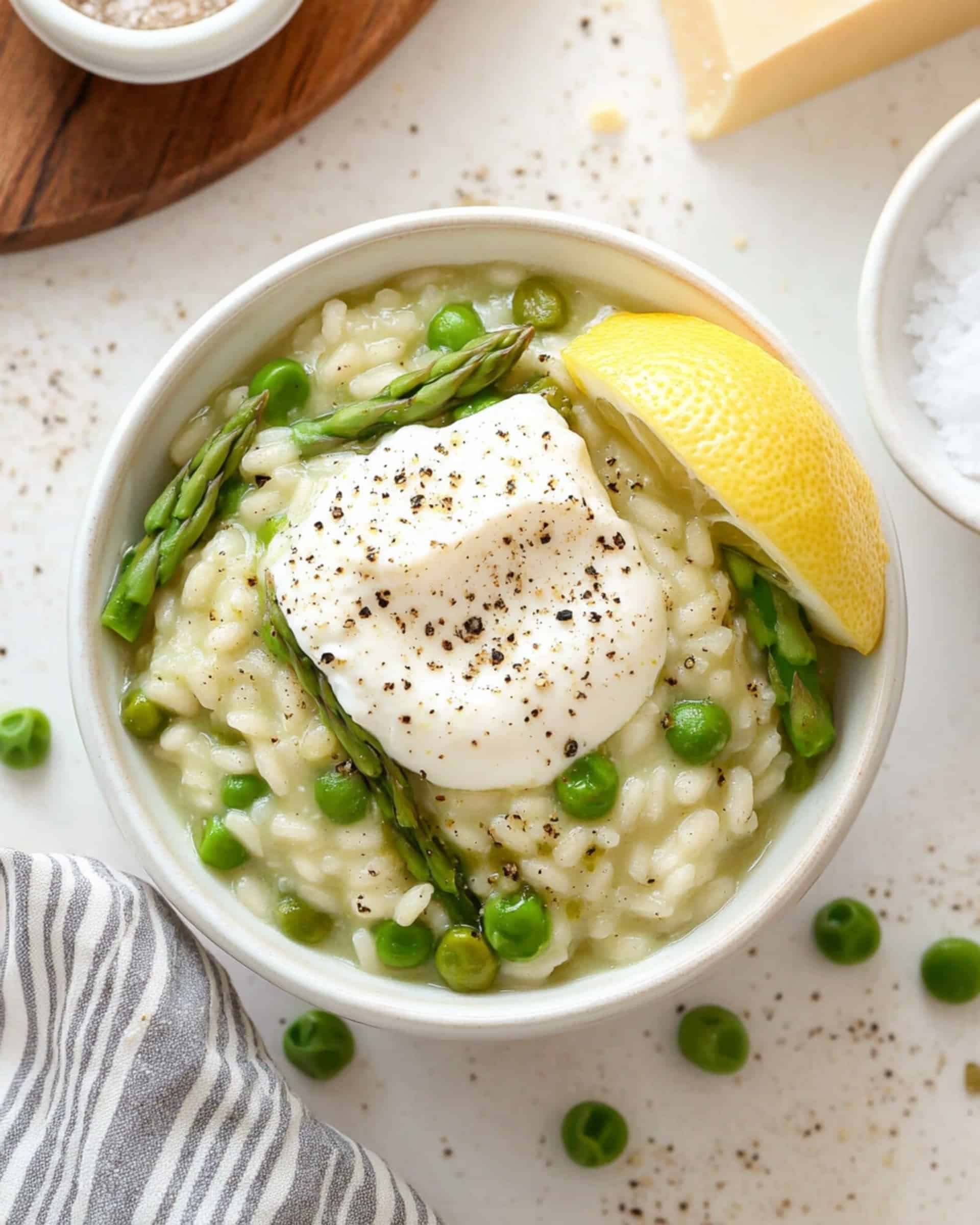
This vibrant Pea and Asparagus Risotto with Burrata is a celebration of spring in every bite. Creamy arborio rice mingles with tender asparagus and sweet peas, all topped with luscious burrata that melts into the warm risotto. Ready in about 40 minutes, it’s an impressive yet approachable dish that brings restaurant-quality flavors right to your dinner table.
Why You’ll Love This Recipe
- Impressive yet simple: This risotto looks and tastes like something from a fine restaurant, but it’s surprisingly straightforward to make at home.
- Perfect balance of flavors: The earthiness of asparagus, sweetness of peas, tanginess of lemon, and creaminess of burrata create a symphony of flavors in every spoonful.
- Versatile: Works beautifully as a main dish for a vegetarian meal or as a stunning side for a special dinner.
- Comforting: There’s something deeply satisfying about stirring a pot of risotto and watching it transform into a creamy, luxurious dish.
Ingredients You’ll Need
- Arborio rice: The star of any risotto, this short-grain rice releases starch as it cooks, creating that signature creamy texture without adding cream.
- Vegetable broth: Provides the flavor foundation for your risotto. Chicken broth works wonderfully too if you’re not keeping it vegetarian.
- Onion and garlic: These aromatics form the flavor base of the dish, adding depth and complexity.
- White wine: Adds acidity and depth. Choose a dry white you’d enjoy drinking – never cook with wine you wouldn’t drink!
- Asparagus: The quintessential spring vegetable brings color and earthy flavor. Look for bright green stalks with tight tips.
- Peas: Sweet little gems that pop with freshness. Frozen peas work perfectly here as they’re picked and frozen at peak ripeness.
- Lemon juice and zest: Brightens the entire dish with a zippy freshness that cuts through the richness.
- Parmesan cheese: Adds salty depth and even more creaminess to the risotto.
- Burrata: This decadent cheese with its creamy center is the crowning glory of this dish, creating pockets of incredible richness.
- Olive oil: Use a good quality extra virgin olive oil for the best flavor foundation.
Note: You’ll find the complete list of ingredients, along with their exact measurements, in the printable recipe card at the bottom of this post.
Variations
Make It Your Own
- Protein addition: Add grilled chicken, sautéed shrimp, or pancetta for a non-vegetarian version.
- Different vegetables: Swap asparagus for artichokes, spinach, or mushrooms depending on the season.
- Cheese alternatives: If burrata is unavailable, try fresh mozzarella, goat cheese, or an extra helping of Parmesan.
- Herb it up: Stir in fresh herbs like basil, mint, or chives just before serving for a bright finish.
How to Make Pea and Asparagus Risotto with Burrata
Step 1: Prepare Your Base
Bring your vegetable broth to a simmer in a separate pot. Meanwhile, heat olive oil in a large saucepan and sauté the diced onion until soft and translucent. Add the minced garlic and cook just until fragrant – about one minute. This aromatic base sets the stage for your risotto.
Step 2: Toast the Rice
Add the arborio rice to the onion mixture and stir to coat every grain with the flavorful oil. Toast the rice for about two minutes, stirring constantly. This crucial step helps the rice maintain its structure throughout the cooking process.
Step 3: Add Wine and Begin the Broth
Pour in the white wine and let it bubble away, stirring until almost completely absorbed. Then begin the heart of risotto-making: adding warm broth in stages. Add just 1/2 cup of simmering broth at a time, stirring gently until absorbed before adding the next ladle.
Step 4: Cook the Risotto
Continue this rhythmic process of adding broth and stirring for about 20 minutes. The rice will gradually become creamy while still maintaining a slight firmness. On your final addition of broth, add the asparagus pieces to cook them perfectly alongside the rice.
Step 5: Finish with Freshness
Stir in the thawed peas, lemon zest, and Parmesan cheese. The residual heat will warm the peas while maintaining their bright color and fresh flavor. Season with salt and pepper to taste, and finish with a squeeze of lemon juice for brightness.
Step 6: Serve with Burrata
Portion the risotto into bowls and top each serving with torn pieces of creamy burrata. The warm risotto will slightly melt the cheese, creating an irresistible combination of textures and flavors.
Pro Tips for Making the Recipe
- Keep the broth hot: Use simmering broth rather than cold – this maintains the cooking temperature and creates a creamier result.
- Stir with intention: Gentle, constant stirring releases the starch from the rice, creating that signature risotto creaminess.
- Don’t rush: Risotto rewards patience. Add the broth slowly and give the rice time to absorb each addition.
- Season at the end: Wait until after adding the Parmesan to adjust your final salt levels, as the cheese contributes saltiness.
- Serve immediately: Risotto waits for no one – it’s at its creamy best right off the stove.
How to Serve
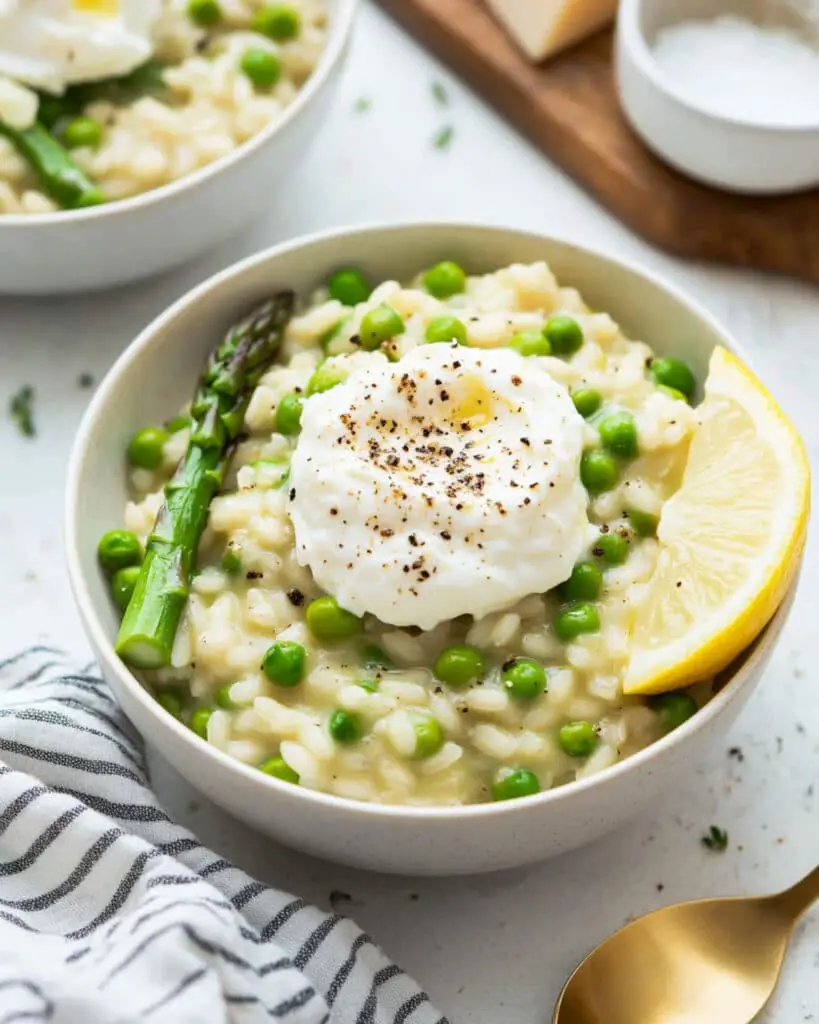
This risotto shines as the star of the meal, but pairs beautifully with complementary sides:
Perfect Pairings
- A simple arugula salad with lemon vinaigrette brings peppery freshness
- Roasted cherry tomatoes add sweet acidity that balances the creamy risotto
- Crusty bread for soaking up every last bit of the flavorful broth
- A crisp white wine like Pinot Grigio or Sauvignon Blanc makes an ideal beverage pairing
Make Ahead and Storage
Storing Leftovers
This risotto is best enjoyed fresh, but leftovers can be stored in an airtight container in the refrigerator for up to 2 days. The texture will thicken considerably when chilled.
Reheating
Gently warm leftover risotto in a saucepan with a splash of broth or water to loosen it back to a creamy consistency. Stir frequently and add additional liquid as needed to restore the original texture.
Note: Store any unused burrata separately and add it only after reheating the risotto for the best texture contrast.
FAQs
Can I make this risotto without wine?
Absolutely! Simply replace the wine with an equal amount of additional vegetable broth. You might want to add a squeeze of lemon juice during cooking to make up for the acidity the wine would have provided.
My risotto isn’t getting creamy. What am I doing wrong?
The key to creamy risotto is constant, gentle stirring which helps release the starch from the rice grains. Also, make sure you’re using the right type of rice – arborio, carnaroli, or vialone nano are traditional risotto varieties with the high starch content needed for creaminess.
Can I make this vegan?
Yes! Skip the burrata and Parmesan, and instead finish with a drizzle of good olive oil and nutritional yeast for umami flavor. Many stores now carry excellent vegan cheese alternatives if you’d like to maintain that creamy element.
Do I really need to add the broth gradually, or can I just add it all at once?
The gradual addition of broth is essential to proper risotto texture. Adding it all at once would essentially boil the rice rather than creating the creamy, starchy sauce that makes risotto special. The stirring and gradual liquid addition are what transform simple ingredients into something magical.
This Pea and Asparagus Risotto with Burrata brings together the best of seasonal produce with satisfying comfort food. The technique might seem intimidating at first, but once you’ve made it once, you’ll find the rhythmic stirring almost meditative. The payoff is immense: a restaurant-worthy dish that celebrates the vibrant flavors of spring. Give yourself the gift of this special meal – it’s the perfect way to slow down and savor the simple pleasure of a beautifully prepared dish.
Print
Pea and Asparagus Risotto with Burrata Recipe
- Prep Time: 5 minutes
- Cook Time: 35 minutes
- Total Time: 40 minutes
- Yield: 6 servings
- Category: Main-course
- Method: Stovetop
- Cuisine: Italian
Description
A luxuriously creamy spring risotto featuring tender asparagus and sweet peas, crowned with a dollop of rich burrata cheese that melts into the warm rice, creating an indulgent vegetarian meal perfect for special occasions.
Ingredients
- 6 cups vegetable broth (or chicken broth)
- 2 tablespoons extra virgin olive oil
- 1 cup yellow onion, finely diced (125g)
- 3 cloves garlic, minced
- 1/2 cup dry white wine
- 2 cups arborio rice or carnaroli rice, rinsed (360g)
- 1 lb asparagus, tough ends trimmed and stalks cut into 1-inch lengths (500g)
- 1 cup thawed frozen peas (170g)
- 1 tablespoon lemon juice
- 2 teaspoons lemon zest
- 1/2 cup freshly grated Parmesan (30g)
- 1/2 teaspoon kosher salt, or to taste
- 1/4 teaspoon ground black pepper, or to taste
- 8 oz burrata, divided (226g)
Instructions
- Prepare the Stock: Bring stock to a simmer in a medium saucepan. Keep it hot throughout the cooking process as warm stock incorporates better into the risotto and maintains the cooking temperature.
- Sauté Aromatics: Heat olive oil in a large saucepan or dutch oven over medium heat. Add the onion, cooking until soft and translucent, about 4-5 minutes. This creates the flavor foundation for your risotto, so don’t rush this step.
- Add Garlic: Stir in the minced garlic and sauté for 1 minute longer, just until fragrant. Be careful not to burn the garlic as it will become bitter.
- Toast the Rice: Pour in the arborio rice and stir until it is coated with the olive oil and onions. Toast the rice for about 2 minutes, stirring frequently. This crucial step helps create the perfect texture by sealing the exterior of each grain while leaving the center able to slowly absorb liquid.
- Add Wine: Add the dry white wine and let cook for about 2 minutes, until the rice has absorbed the wine. Reduce the heat to medium-low. The alcohol will evaporate, leaving behind a wonderful depth of flavor.
- Begin Adding Stock: Once the vegetable stock is simmering, carefully add 1/2 cup to the rice mixture. Stir continuously with a wooden spoon, until the stock is almost completely absorbed. Keep adding 1/2 cup stock at a time, stirring until almost absorbed before adding the next 1/2 cup.
- Cook Asparagus: On the last addition of stock, add the asparagus with the stock. This process of adding the stock will take about 20 minutes in total. The rice should be really creamy, yet still al dente. Adding the asparagus at this stage ensures it cooks to the perfect tenderness without becoming mushy.
- Finish with Remaining Ingredients: Stir in the peas, lemon zest and grated parmesan cheese. Season with salt and pepper. Let cook an additional minute until the peas are heated through. The residual heat will warm the peas while maintaining their vibrant color and sweet flavor.
- Serve: Portion out into bowls. Add 1-2 oz of burrata into each bowl. Serve with additional salt, pepper and lemon wedges if desired. The heat from the risotto will begin to melt the burrata, creating an extraordinarily creamy and indulgent dish.
Notes
- For the creamiest result, never stop stirring your risotto during cooking. This constant agitation helps release the starch from the rice.
- Arborio rice can be substituted with carnaroli rice, which some chefs prefer for its higher starch content and firmer texture.
- For a vegan version, omit the burrata and Parmesan, substituting with nutritional yeast and a drizzle of olive oil.
- Fresh peas can be used instead of frozen when in season – add them at the same time as recommended for frozen peas.
- Leftovers can be stored in the refrigerator for up to 3 days, though risotto is best enjoyed immediately after cooking.
- If you are gluten-free, be sure to check all ingredient labels to make sure they are gluten-free. Vegetable broth is one to be careful of as some brands do contain gluten.
Nutrition
- Serving Size: 1 serving
- Calories: 385
- Sugar: 4g
- Sodium: 650mg
- Fat: 13g
- Saturated Fat: 6g
- Unsaturated Fat: 7g
- Trans Fat: 0g
- Carbohydrates: 55g
- Fiber: 4g
- Protein: 14g
- Cholesterol: 30mg

